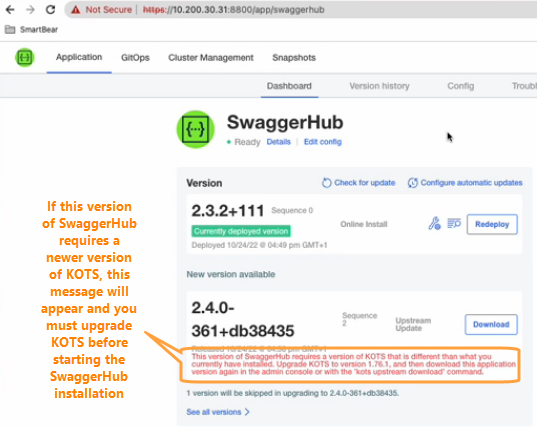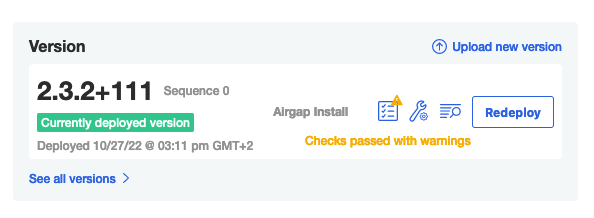Upgrading a 2.x installation
Caution
Changes to the Bitnami catalog were announced recently and will take effect on August 28,. Due to these changes, some SwaggerHub On-Prem users may need to take action. Find out if you are affected and learn about the remediation patch.
Warning
Customers on version 2.4.1 or older 2.x VM installs with internal databases MUST first update SwaggerHub to 2.6.1 before proceeding with the 2.9 upgrade. This does not affect migrating 1.x customers, as it is covered in Migrating from SwaggerHub on-Premise 1.x to 2.x.
Warning
Upgrading a VM Installation to 2.9 involves significant upgrades to components that will necessitate additional manual actions before and during the installation process. To find out more, go to Upgrading KOTS.
Warning
You must make Ingress changes before you upgrade to version 2.9. Learn more here. With AWS Elastic Kubernetes Service (EKS), make sure you follow pre-installation preparations. Learn more here.
This page contains instructions for how to upgrade your current 2.x installation to a newer 2.x release. For instructions how to update a 1.x installation to 2.x, click here.
Note
Before installing or upgrading, see OpenShift Installation - Online and Kubernetes Installation - Online and follow the installation instructions.
Step 0. Backup your System
Before doing any system upgrades, be sure to do a complete system backup.
Step 1. Check if an upgrade is available
When a new release is available, you will usually see it in the Admin Console. If no updates are automatically displayed, you can click Check for Update to see if any updates are available.

If you need to upgrade KOTS before you can install the new version of SwaggerHub, you will see a notice on the upgrade area:
 |
If you need to upgrade KOTS, the instructions are here: link.
Step 2. Upgrade SwaggerHub
Note that newer versions of 2.x may run additional preflight checks.
There are three different upgrade processes, described below.
Upgrading SwaggerHub on an Existing Cluster or VM/Embedded Cluster - online
Installing on an existing cluster is simple: click on the Download button. Once the download is complete, click Deploy to install the upgrade.
 |
Upgrading SwaggerHub on an Existing Cluster - airgapped
Log in to the download portal using the link and password provided when you purchased your license for SwaggerHub. If you have lost your credentials, file a ticket with tech support.
Follow the instructions on this page to download the installation files.
Then upload the files to your installation by clicking on Upload new version:

Upgrading SwaggerHub on an VM/Embedded Cluster - airgapped
Log in to the download portal using the link and password provided when you purchased your license for SwaggerHub. If you have lost your credentials, file a ticket with tech support.
Run the following command:
kubectl kots upstream upgrade <app slug> --airgap-bundle new-app-release.airgap -n default
For example, you might issue the command:
kubectl kots upstream upgrade swaggerhub --airgap-bundle SwaggerHub-2.4.0-369+c161fd1.airgap -n default
This command can take some time to execute.